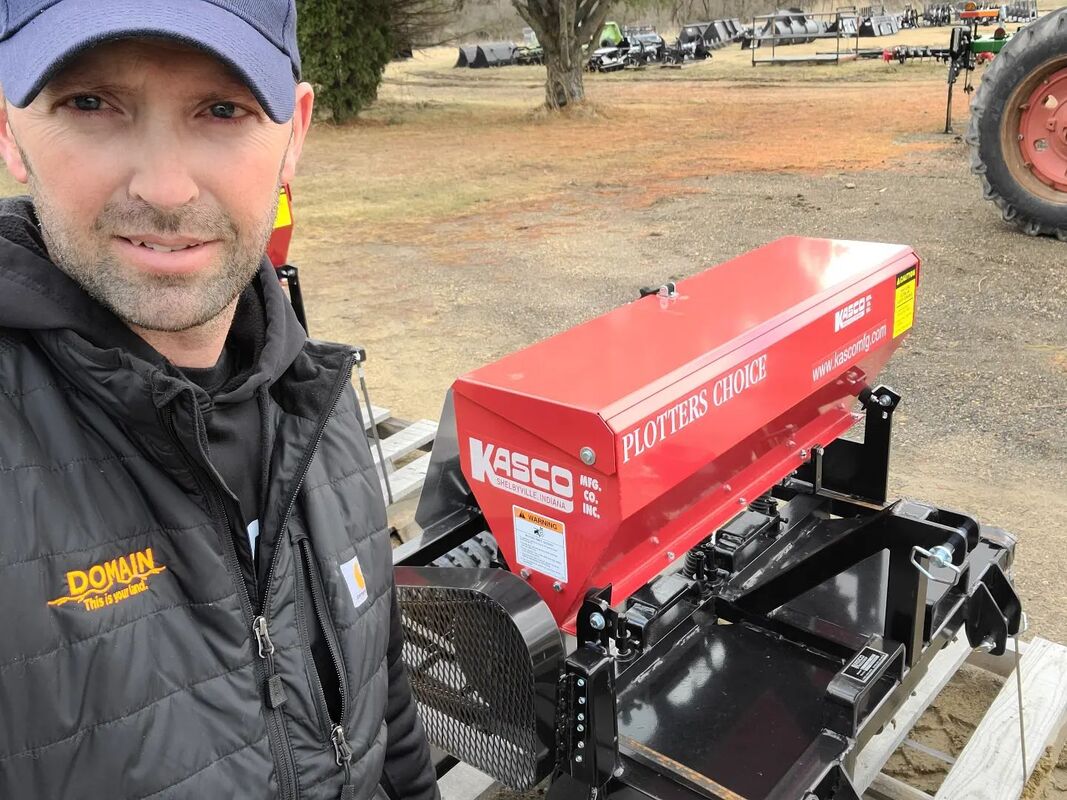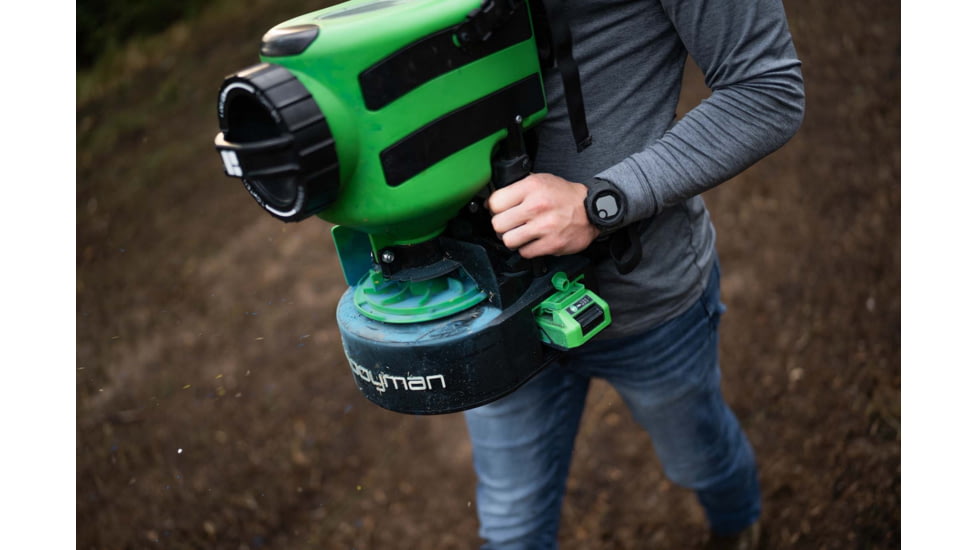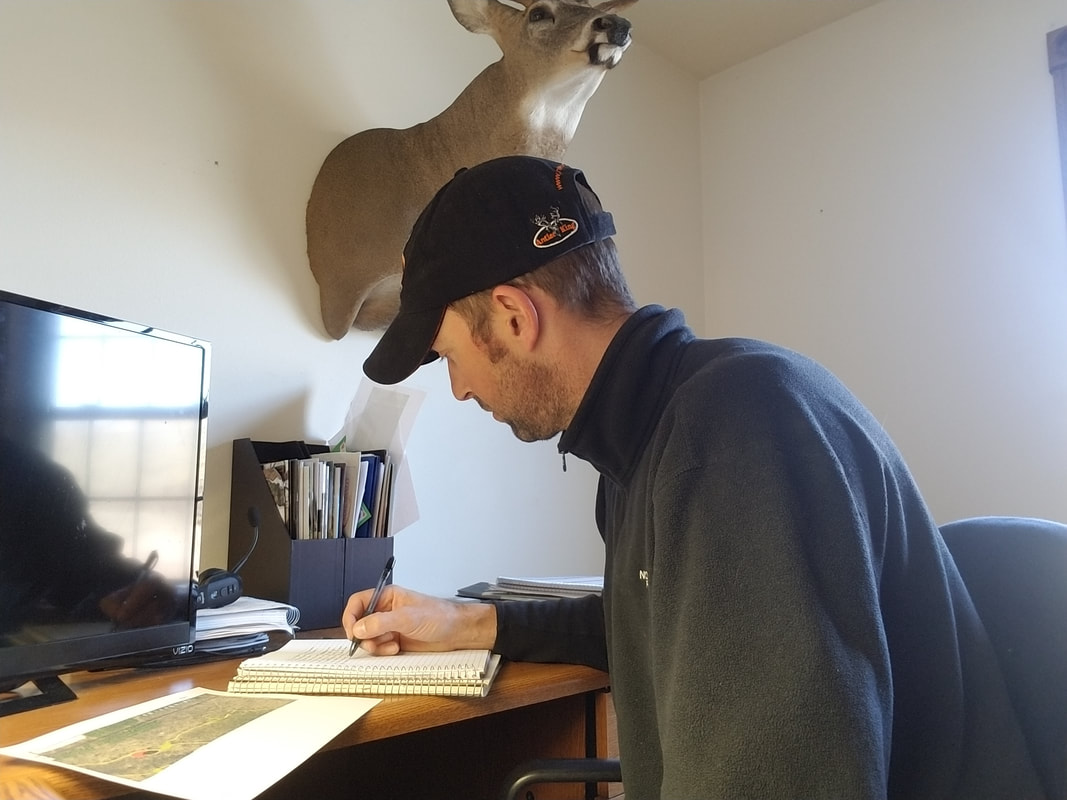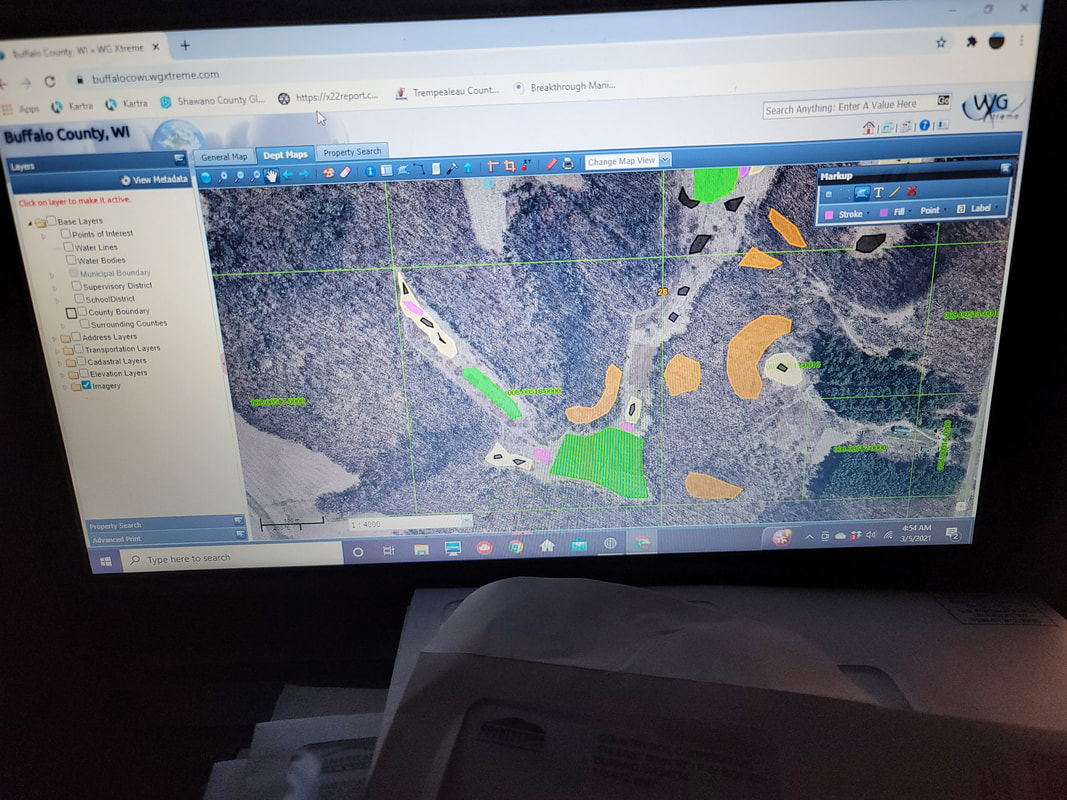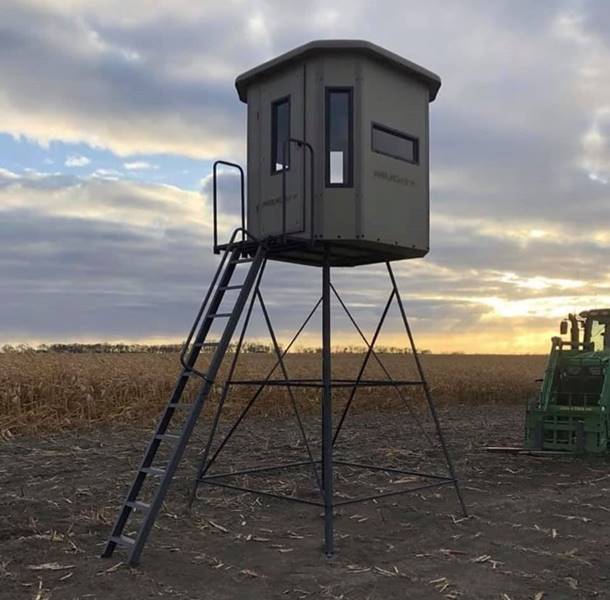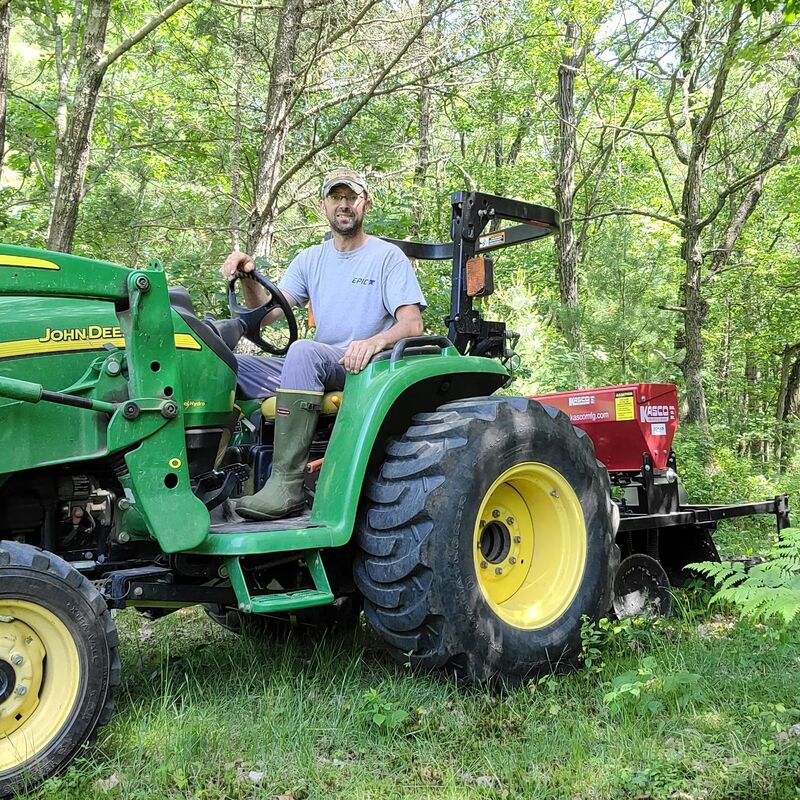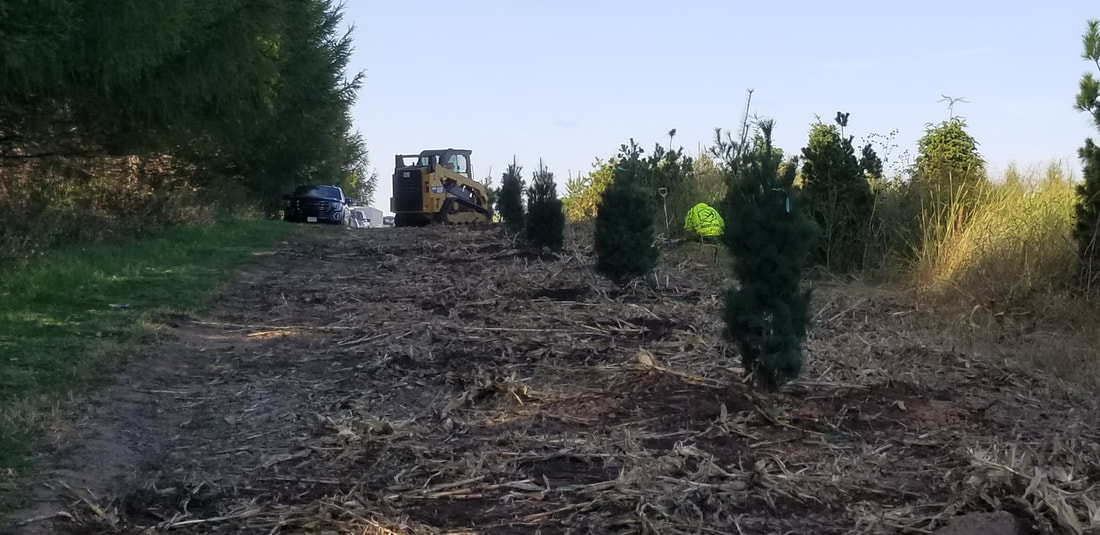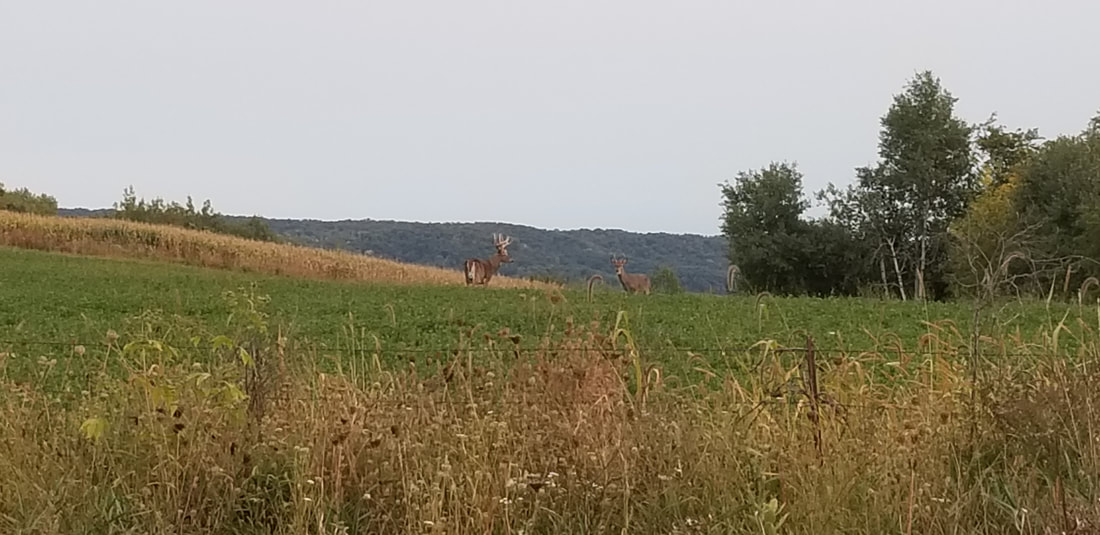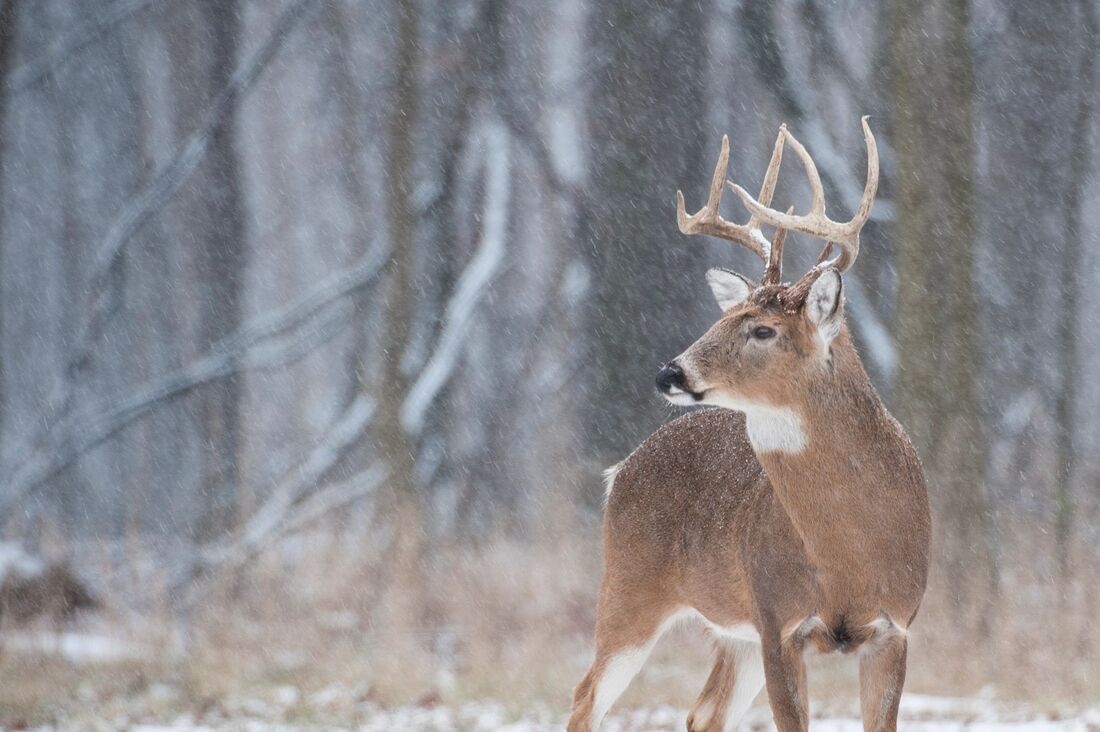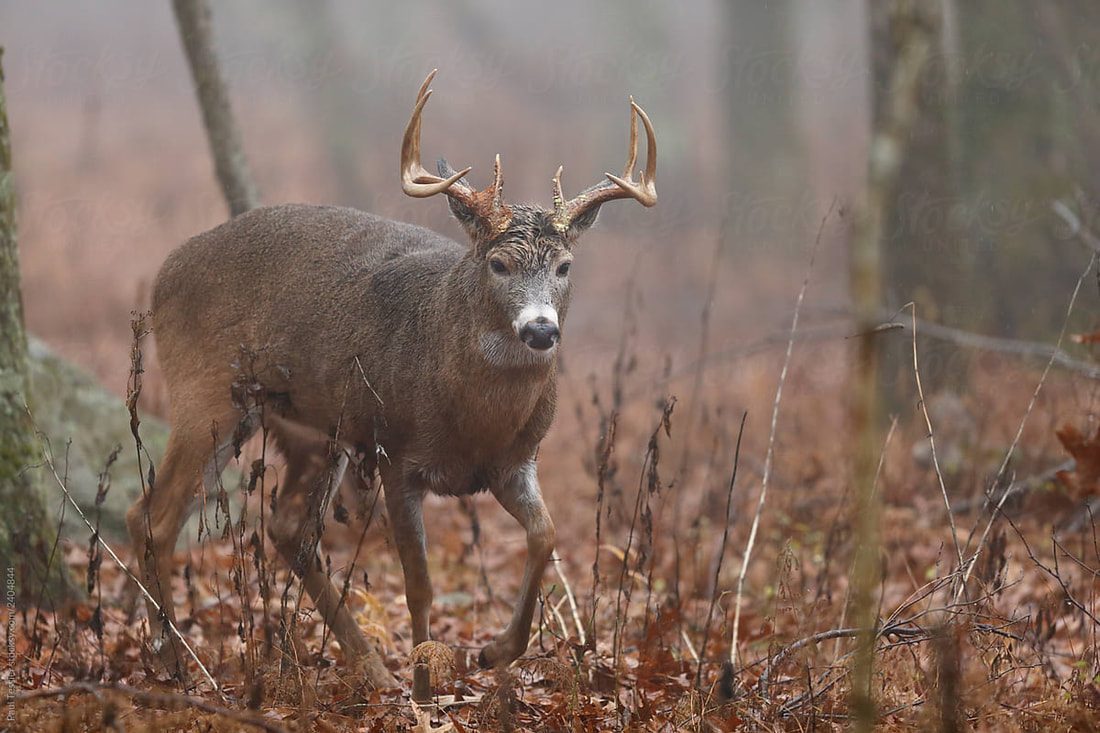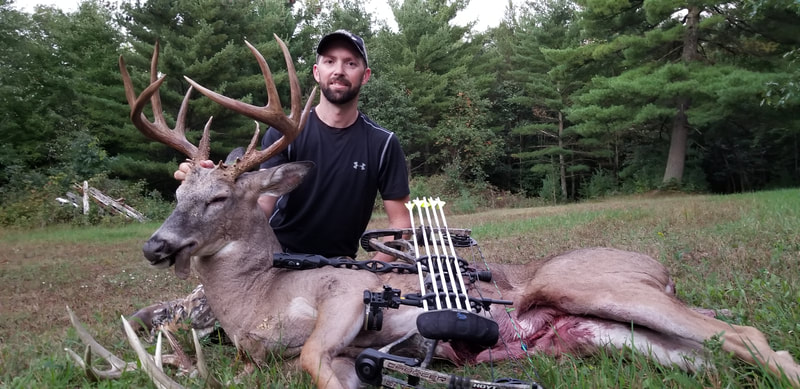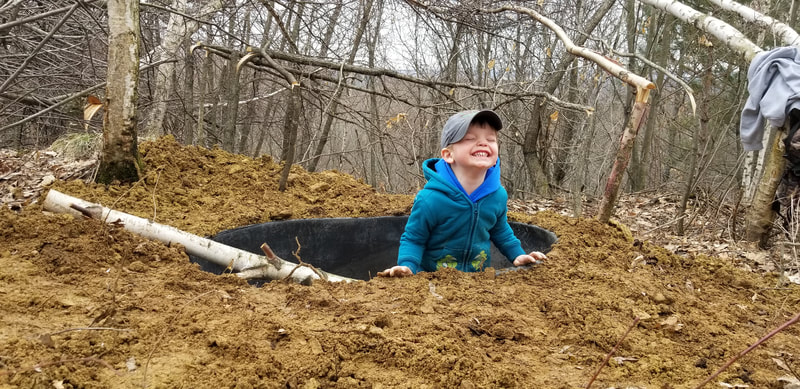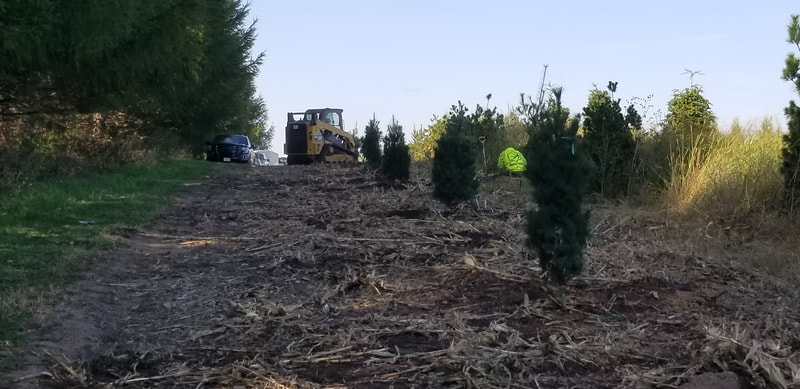|
By: Ryan Nordahl Owner: Epic Whitetail Habitat, LLC email: [email protected] If you are anything like me, then you are probably anxiously waiting to start getting seed on/in the ground this spring. Whether it's frost seeding clover, chicory, and/or switchgrass. Or seeding other food plot favorites like corn, soybeans, buckwheat, sunflowers, annual screening, etc., how you execute the process can at times be overwhelming. I see it on social media every spring, "Looking for a food plot seeder that won't break the bank." And i totally get it. We want to complete any job with the least amount of effort in the least amount of time possible. But most of us are at times strapped for cash or simply don't want to spend mega bucks for 15 minutes of fame come fall. And that's perfectly fine and very understandable. You have options. Because let's face it, not all of us have the deep pockets of those we see on the OUTDOOR Channel. But we do have hunting land, and we want to make it the best we can to provide food or cover for deer and other wildlife with the least amount of financial investment. Over The Shoulder Broadcast Spreaders Over the shoulder broadcast seeders are probably the most utilized type of seeders I see being used to establish food plots. And I use and absolutely love my Earthway model 3100 hard sided hopper seeder and my model 2750 bag seeder religiously throughout every growing season. They are absolutely a life saver for me. And I really love the model 3100 when it comes to applying lime and fertilizer to my small, hard to get to kill plots on the properties that I manage. And also my on properties, as well. I have included a short review video posted above this section for you to check out. And I cannot say anything bad about my trusty 2750 model bag seeder either. I can broadcast just about any size seed there is with this spreader. But the only drawback sometimes can be filling a bag seeder when two hands are needed to pour seed into the bag which sometimes bag seeders can at times collapse. A real pain in the you know what! Haha! The video below shows you what I use and how to use it when filling any bag seeder. be sure to check it out. Battery Powered Over the Shoulder Broadcaster New in 2022, Hooyman came out with an all electric, 24 volt broadcaster. The 24V Lithium-Ion Chest Spreader makes spreading faster, easier and more comfortable. An adjustable throttle allows you to change the speed rate on the go. Their proprietary throwing disc maximizes throwing distance for a more uniform spread pattern. With a continuous run time of 3 hours, you’ll be able to get most jobs done on one charge with it's lithium ion battery. The video below gives you a great perspective of how this broadcaster operates. Be sure to check it out. Tractor, ATV/UTV Seed Drills If you are fortunate enough to own a tractor, an ATV, or UTV, you have probably been in the market for some type of grain drill type seeder to pull behind whatever type of workhorse you may have. But most hesitate from these types of options when the see the price tags on the majority of brands. But what's it worth to you? They save time (which we don't get back, especially when it comes to family, other loved ones, friends, and/or other commitments & priorities), are easy to adjust for seed rate, and believe it or not, can put a little extra cash back in our pockets. How so? I have been fortunate enough through hard work to pay cash and have a couple of different brands of implements for getting food plots in not only for myself, but others as well. Of which, they have become perennial clients, which in turn helps to offset the cost of owning a machine for a tractor or ATV. What are you willing to do in order to buy one of these great time savers? My latest brand, which I highly recommend to anyone looking to go this route, is Kasco Manufacturing. I use the 3 point mount Plotter's Choice model for the tractor I use. I've had great success with this model which allows even greater time savings as it IS a no-till drill made for sub-compact tractors. Pull type models are also available for ATV/UTV use. The video below is a video I put together in 2022 reviewing the Plotter's Choice model from Kasco Mfg. Please be sure to check it out for yourself. So in conclusion, choose a seeder which fits your goals in conjunction with your budget and ambitions. I'm not here to sell you anything. Just relaying the options that are available to you to help you get the job done maybe a little easier in 2023 and beyond.
Most importantly though, just have fun!
0 Comments
6 Winter Deer Habitat Strategies You Can Begin to Implement Immediately By: Ryan Nordahl email: [email protected] With the whitetail seasons winding down, or now even closed for the season, in a few states, now is a great time to get out onto your hunting property, private and/or public, and start your scouting and planning for the next season. The recent hunting season is fresh in your mind. If you've kept a journal to log your observations and thoughts for the following season, then now is the time to stretch your legs and dust off your walking shoes. And perhaps it's even time to start looking for new habitat equipment such as food plot seeders or other equipment if your budget will allow. My hope is that the following 6 tips help you in your planning and implementation for the next deer season. So, let's dive in... #1: Scouting & Planning Late fall and early winter can be the best time to start scouting the property you hunt, be it private or public land. Especially if you hunt an area that has little to no snow cover this time of the year. Ground scrapes, rubs, fall travel corridors, etc. are easily prevalent at this time and can offer you a glimpse into where the bucks were most frequenting during the heart of the rut. And it is also a great time to look back through the previous seasons trail camera intel. Also, if you are a late season hunting fanatic like I am, it could also be a time to scout out that lone survivor that slipped by during the earlier parts of season. If you at all keep a weather/hunt log like many seasoned hunters do, you can begin to put a particular deer's tendencies together. And if that particular buck made it through all of the gunfire, the intel you gathered this season could make the next season with the same buck that much more predictable. The winter months bring many to checking out the YouTube gurus for the latest tips and tricks. Not that any of the advice you here from these individuals is a bad thing, because it's not, you have to practice and implement what works best for your property in your geographical location of a whitetails domain. And this may be a time where you'd want to hire one of these experts to your property to help you design a plan best suited for your area and catered to your individual goals. Many of these well regulated experts can also help you come up with the best hunting strategy for public land as well. But just remember, you get what you pay for with these types of service experts. The higher their daily rates, you can be rest assured they typically bring more value above and beyond your expectations. So don't let sticker shock influence a knee jerk reaction. Do your research. Most, like myself, have many references readily available upon request to legitimize the value they represent in their daily rates. Just remember, a second set of eyes from that of a mature buck and habitat expert can bring you a lifetime of precious value for years to follow. #2: TSI & Hinge Cutting Further developing the cover given by local natural surroundings assets is basic for future achievement and winter is the ideal chance to get to work. In the event that you have a property with homogenous stands of hardwood timberlands you might consider accomplishing some chain saw work. In an open stand of woods there is almost no ground cover for deer. Keep in mind, security cover for deer exists between ground level and roughly three feet up. While Timber Stand Improvement can accomplish numerous objectives, the center accentuation is frequently to open up the canopy and to release favored trees specifically. By opening up the high canopy you will see a quick change this spring with new development of forbs and ground vegetation. This new development assists with browse and cover, so it resembles solving two problems at once. Hinge cutting is the famous timber stand improvement process in which you saw part of the way through a tree and afterward bend it over to the ground to give living cover and browse to deer. While you can truly hinge cut trees during any season, winter is the best time. For one, the trees are dormant throughout the colder time of year, in this way, you'll encounter a superior endurance rate. Also, it's more comfortable working conditions - it's not excessively hot out, and there's no bugs and leaves to irritate you day in and day out. It's likewise much more straightforward to see what you're doing and where the trees are falling in winter contrasted with the green jungle of summer. Ultimately, hinge cutting throughout the colder time of year permits time for deer to find and use these new safe-haven thickets and browse features. But please, if you've never hinge cut a tree, or have any hesitation whatsoever, contact a professional such as a logger or hinge cutting expert. Hinge cutting is one of the most valued services Epic Whitetail Habitat, LLC provides for its clients. With 10+ years of experience under my belt, I've seen a thing or two, but it ultimately leads to better deer habitat and ambush hunting opportunities. Click on the video above this section to learn about hinge cutting and if it's the right fit for your private hunting property. #3: Game Camera Surveys The best times to lead camera studies are during August and in January before bucks start to shed their antlers. Leading a yearly game camera survey will give a significant measure of data relating to the deer herd. Sex ratios, deer density, buck age class, antler improvement, and fawn recruitment numbers can be generally assessed by directing a game camera review. #4: Planning Food Plots When it comes to food plots it's not a one size fits all game. Evaluate what has worked over the course of time on your property if you've been doing food plots for a while. If you are new to the game of food plotting and consider yourself "not a farmer" whatsoever, now is the time to chat with someone with experience. And my best advice would be to consult with a local farmer or agronomist from the area where you hunt. They understand soil types and conditions best. And believe it or not, most are willing to help you be successful at growing food sources that will excel long after the surrounding ag fields in your area have been harvested, if your property is located in farm country. For big woods areas like that of northern Wisconsin, Minnesota, Michigan, etc., you must understand that not all traditional food plot vegetation is created equal. Whether it's traditional green forage food plot varieties, hard and/or soft mass producing trees and shrubs, you must consider where you are located and choose varieties congruent with your growing zones. Bottom line, now is the time to look back on the previous season and evaluate what worked, what could be improved or done better, and how can we capitalize maximization the following food plot season? What soil types are we dealing with? What is our current soil pH levels? What's our organic matter within the top 2" of soil? How can we increase organic matter? How can we reduce soil erosion if on slopey terrain? How can we minimize deer browse pressure before the hunting season? Are conventional or organic cultivation practices best for our goals? How can we reduce costs for our food plot program the following growing season? Are there cost savings on particular seed and other inputs that we intend to implement the following growing season before the end of the year (December 31)? These and many more questions can be answered by reaching out to the local seed, fertilizer, chemical and agronomy dealers in your area to help you manage and maximize your allocated budget for the following growing season. Knowing the answers to these questions can result in significant savings to help you come in well under budget ahead of time, which can lead to keeping your significant other happy, if you are married to a non-hunter like I am. HAHA! #5: Consider New Equipment The winter months can also be a great time to consider new hunting or habitat equipment for the following year as well. Many retailers and equipment dealers could possibly be offering year end savings deals to help reduce inventory carryover. Things to think about and to consider might be new box blind tower stands, tree stands, food plot implements, tractors, ATVs/UTVs, etc.. To check out my review of the Kasco Plotters Choice no-till drill from Kasco Mfg, Click Here for the video review. #6: Ordering Trees & Shrubs Winter is the time to start ordering any trees and/or shrubs that may be part of your plan for the following spring. Many local tree nurseries, green houses, county extension services are now taking orders for spring delivery, with most pre-order savings deadlines happening by January 31. Conclusion I understand many of my readers reading this have been through the rigors of the season and would rather not think about deer or hunting strategy for the following year, and that's just fine and dandy. I understand. Especially when it comes to spending more precious and valuable time with family and friends during the busy Christmas season.
But if you are anything like me and take your whitetail hunting serious, you realize that deer season never truly ends. And that is why winter is the perfect time to evaluate the previous season and plan ahead for the following season to help put you ahead of the curve. And if you should need help, whether you hunt private or public land, looking to purchase a new parcel of whitetail heaven, or just to run your own plans by a second set of eyes, don't hesitate to reach out to someone that can help you set and achieve your goals. Epic Whitetail Habitat, LLC is an excellent resource to start helping you implement a plan to send you down the right path.
By: Ryan Nordahl Owner: Epic Whitetail Habitat, LLC Email: [email protected]
Most hunters consider late season deer hunting to be one of the most challenging times to hunt whitetail deer, but if you know how to tackle the challenges that come with late season mature whitetail success, you can turn these challenges into opportunities to kill some big bucks yet this fall/winter. This is exactly why I’ve written the following article to help you make the most of your chances at mature whitetail success when hunting deer later in the season. Be sure to keep reading below! The Rut Is Over, Now What? Bow hunting late in the season for mature whitetails can be incredibly rewarding. Despite the rut being over, many hunters find success in harvesting big bucks during the late season. As the days get shorter and temperatures drop, mature whitetail deer begin to enter their winter patterns. Understanding how deer behave and adjust their habits during this time of year can greatly increase your odds of success. First and foremost, it’s important to know where to focus your hunting efforts during the late season. Mature whitetail bucks often move to more remote areas of their home range, away from areas they may frequent during the pre-rut and rut. As the breeding season ends, bucks begin to focus on replenishing their energy reserves that were depleted during the rut. The most successful bow hunters will focus on areas near food sources such as acorns, crop fields, and other nut-bearing or fruit trees. During the late season, these are prime spots for bow hunters to intercept mature bucks as they feed during the day. Scouting is an important component of late season bow hunting success. Try to identify key bedding areas, travel routes, and food sources that could attract mature whitetail deer. Using trail cameras can be an effective way to scout these areas and gain insight into where the mature bucks are located and when they are active. Another important consideration when hunting late season whitetails is weather. During cold snaps, whitetail deer often become less active during the day, making them more difficult to hunt. To have success hunting late season whitetails, you must be willing to adjust your strategy based on conditions and stay in the field as much as possible. Overall, with a little preparation and dedication, bow hunting for mature whitetails during the late season can be extremely rewarding. By understanding the behavior of deer during this time of year, you can increase your chances of success and harvest a trophy buck before the season ends! Hunt Areas with Food Late season deer hunting can be a productive option for harvesting mature whitetails. Consider looking for food sources such as soybeans, corn and rye/wheat fields that are typically harvested or left standing at this time of year. These fields will provide an abundance of food sources for deer, which makes them more likely to enter your hunting area. If you're bow hunting, late season is a great opportunity to hunt mature whitetails! These deer can actually have greater tendencies to repeat certain patterns than in the early stages of the hunting season. And with extremely cold temperatures and rising barometric pressure, the need for a all but physically drained buck to "stoke the fire" becomes increasingly urgent, giving you the possible opportunity needed to kill him. Where To Set Up During the late season, many hunters love to sit over a food source that they know deer will be hitting late in the afternoon. And although this can definitely be an effective strategy to bring down a mature buck, to increase your odds of catching him off guard during legal shooting hours it may be more effective to try to intercept him in a travel corridor between his known bedding area and his preferred food source. And having mock scrapes in his travel corridor may just give you the split second time you need to draw your bow and give you a great shot opportunity. But the late season can have it's drawbacks when it comes to hunter concealment. The chances of you being "sky-lined" in a barren landscape increases significantly. Strategically placed box blinds, ground blinds, and well hidden tree stands are very important during the late season. In a hardwoods setting, look for trees not only still holding their leaves, but also provide multiple tree trunks and/or branches to break up your human outline even more. Maybe you don't even have to hunt that high if you so choose to hunt from an open hang-on type or ladder stand. Some of the best setups for late season may only need to be 6 to 8 feet off of the ground, considering the cover around the stand. If at all possible, look for stand locations amongst a dark evergreen backdrop. But be aware that a thick stand of evergreens could mean thermal cover for deer this time of year. So study the area you are going to hunt well in advance of your planned hunt. This can be accomplished either in the preceding months leading up to the hunting season or trail camera intel. and if you have the means of using cellular trail cameras, like those of the Tactacam Reveals, even better. But do not jeopardize knowing wind direction and understanding how the thermals can impact your hunt. Again, no matter the time of the season, you must do everything you can to conceal your presence from the deer on your property. All deer must never know of your presence during the hunting season. and this especially critical during the late season. Wrapping Up As stated in the beginning, the late season can be even more predictable than in the early stages of the hunting season. But always take into consideration how the deer have been pressured and how the deer have been conditioned to an over abundance of human pressure throughout the hunting season up to this point. Deer this time of year are very easily spooked. so be aware of you surroundings and how you are moving through the area you are hunting and while on stand. But most importantly, above all else, take it all in and just have FUN!  6 Tips For Late Season Whitetail Hunting Success By: Ryan Nordahl, owner of Epic Whitetail Habitat, LLC email: [email protected] Whether you’re lucky enough to have deer hunting opportunities in your own backyard or if you’re forced to drive hundreds of miles just to have a chance at that perfect buck, late season whitetail hunting success is often as elusive as your quarry itself. But with the right knowledge and preparation, anyone can be more successful during their final hunts of the year, especially if you follow these six tips for late season whitetail hunting success. 1) Use The Wind To Your Advantage Wind is one of the most important factors to successful deer hunting. Deer can hear, see and smell hunters better in calm weather than when it is windy. When hunting deer in late season, use the wind to your advantage by staying downwind of your target. If you are trying to stalk a deer, always approach from down wind, but be aware that it may take more time if you have to cross a ridge or an open field. 2) Set Up Shop Near A Food Source Hunting whitetails can be challenging in the winter because deer have limited food sources and are more sensitive to their surroundings. You can increase your odds of success by hunting near a food source that is concentrated, such as a corn or soybean field, a soft or hard mass orchard. And don't forget about woody browse areas as well. Freshly harvested trees late in the fall or early winter can provide a terrific food source. But be careful to hide your presence due to the possible like of hunter concealment opportunities in clear cut areas of a forested area. If hunting close to or on the preferred food source of the season, be sure to plan your exit well in advance, should deer still be feeding well after legal shooting time is over. In the case of my own failures to do so I have had to wait several hours after dark on well moonlit nights with ample snow because deer were still feeding in the area. Again, deer must never know they are being hunted if you wish to be successful consistently rather than just lucky. 3) Move Slowly And Quietly 1. Move slowly and quietly to avoid alerting the animal to your presence. 2. Stay low and close to the ground, or use natural features of the ground you are hunting such as vegetation and topographical features, as this will make you less visible to deer. 3. Move down wind of your target. 4. Stalk a deer in its bed or feeding area where it is likely to be looking down and standing still, making it easier for you to get a shot off at closer range. 5. If a deer looks in your direction while you are stalking, stop and remain motionless until it looks away, then move again very slowly and quietly until you can resume your approach. 4) Take Advantage Of Cover The best time to hunt is in the afternoon/early evening hours during the late season. The best way to take advantage of this is by getting in position during the early midday hours. If you want to find a good spot for sitting, look for cover such as bushes, fallen trees or walls of conifer that will provide some concealment. Once you have your cover picked out, scout out a location where you can sneak to your stand that will help reduce the possibility of spooking deer as you access and exit. Winter as we all know in the northern regions of the country are a time of scarcity as far as natural foliage for concealment is concerned. If you are a private land owner, or have the right to do so on a lease, planning concealment strategies for access and exit through vegetative options is key to concealing your movement during the late season. 5) Stay Alert Whitetail hunting can be a grueling endeavor, but there are a few things you can do to make the experience more enjoyable. Here are a few tips for late season whitetail hunting success: -Stay Alert: Keeping your senses sharp is the key to any successful hunt. Be aware of your surroundings at all times and keep an eye out for deer movement. If you see something, try to minimize sudden movements. Highly pressured deer are very alert and aware of their surroundings, especially early in late season when most areas of the country are coming out of their recent firearms seasons. Stay on top of trail camera intel, if you are so inclined. Late season, like early season, is a time when you can literally kill a mature buck with higher odds in your favor by sleeping in and "from the couch." Pay close attention to weather patterns as well. An impending storm or dramatic swing in temperature and barometric pressure can once again play a key roll in the amount of deer activity you could encounter. Also, pay very close attention to where deer are feeding and what food sources they are focused on. For the most part, in the late season, deer will concentrate there feeding to higher carbohydrate food sources like corn, soybeans, and woody browse areas in and around their bedding areas. 6) Don't Be Afraid To Hunt Close To Bedding Areas Hunting close to bedding areas can be an effective tactic, but hunters should be aware of the potential for deer to spook and move out of the area. One way around this is to hunt in a box pattern, working your way around a bedding area until you've covered all parts of it. A good technique is to place yourself at one end of the bedding area and watch for movement on the other end. If you are inclined to own property or hunt public grounds with a vantage point overlooking a bedding area, all the better. But be aware of wind direction, how you expect the thermals to rise and fall, and how concealed you yourself are, and where you anticipate the highest volume of traffic out of the bedding areas you expect deer to travel to and from their feeding areas. How To Stay Warm While Deer Hunting: 5 Tips For a Successful Hunt By: Ryan Nordahl Owner: Epic Whitetail Habitat, LLC Email: [email protected] There’s nothing worse than being cold on a deer hunt, but it can happen to even the most seasoned hunters. With these simple tips on how to stay warm while deer hunting you’ll be able to enjoy your time in the woods without freezing your toes off! 1) Wear the Right Clothing The first thing that you need to do is make sure that you are wearing the right clothing. You should be prepared with gloves, hats, boots and appropriate outerwear for the weather. It is important to wear layers that can be added or removed as needed. The best way to stay warm while hunting is by dressing in layers. Wear layers of clothing for warmth and comfort when deer hunting in cold weather. Sitka or KUIU clothing are great brands when it comes to battling extreme cold temperatures. Many hunters find the investment in these quality brands worth every penny. While the majority of hunters find these brands overpriced for hunting clothing. For hunters on a budget, yet looking for an investment into comfort during cold weather, the Heater Body Suit is a great way to help you stay in your stand longer in pursuit of late season whitetails. It allows a hunter to wear less layers while accessing those hard to get to stand locations without working up a sweat. Sweating is the worst thing a hunter can do in cold conditions. 2) Use Hand and Foot Warmers Whether you're hunting in the North, the South, or somewhere in between, it's important to know how to stay warm while deer hunting. One way to do this is by using some hand and foot warmers. These are available at most stores where sporting goods are sold, and they can be used for as long as 12 hours before needing to be replaced. You'll want to buy them early on because they will come in handy during those cold mornings when you're waiting for that big buck of your dreams! 3) Drink Hot Liquids Drinking hot liquids will help you stay warm during a hunt. The higher the temperature of your drink, the better it is for warming you up. Avoid drinks with caffeine and alcohol as they will dehydrate you and make you colder. Hot chocolate, tea, soup, or Black Rifle Coffee are all great choices to keep your body temperature up. 4) Set Up a Portable Heater A great way to stay warm while deer hunting is by setting up a portable Buddy Heater. Heaters can be placed in strategic locations to keep the hunter warm without needing to make too many trips back and forth to the vehicle. There are many different types of heaters on the market, with prices ranging from $30-$400. The higher priced models will offer more features, such as automatic shut-off or dual power sources. 5) Don't forget to pack extra clothes in case you get wet Deer hunting is an exciting time of year. One of the most important things to remember when you go out deer hunting is to dress appropriately for the weather. It's important to pack extra clothes in case you get wet or need additional layers for warmth. The season can be unpredictable and there are many factors that can affect your hunt, so it's always best to be prepared! Some of the best warm weather hunting gear can be found at these fine retailers below. By Ryan Nordahl email: [email protected] Nothing puts a "damper" on deer camp like the chatter of a hard downpour on the rooftop. Unexpectedly, nobody wants to get up, nobody wants to go out, and everybody lounges around mourning the departure of a decent hunting day. I have seen whitetail hunters get together and return home days early on the grounds that rain was in the gauge. What's more regrettable is, the unhappiness outside before long starts to influence the environment inside. Very much like that, a valuable seven day stretch of excursion - - and deer hunting - - is lost. I realize what rain means for deer hunters, yet numerous hunters don't actually have any idea what rain means for deer. As a rule, rain makes next to no difference to whitetails except if it's pouring. At the point when this occurs, all natural life (and human existence) movement slows down until the rain is finished. In any case, when rain is light or just a consistent shower falls, deer simply continue on ahead as though it were a bright day. The error is, "light" rain to a deer might appear to be a soaker to hunter, his garments and his wellbeing (don't get a bug!). Master Ways to chase Whitetail Deer in the Rain During the hunting season, rain is certainly not an obstruction to deer movement. From my experience, whitetails don't fluctuate their tendencies in the slightest when it's raining during the rut. For instance, one of my number one hunting spots is a box blind, ignoring a field corner where deer approach at sunset consistently, all year. I can unwind, have coffee and glass the whole area without being seen and, because of the pressed wood box, I can do it without any anxiety toward getting wet. Deer come to the field consistently besides on exceptionally hot days, incredibly blustery days or when there's a heavy downpour. At some other time, including sprinkle, light rain or even slight downpour, they appear on que: does and fawns first; little bucks straightaway; and afterward, close to dusk, the genuine bruisers I'm after. Regardless, rain makes deer more content and less jumpy. My speculation is the unending deluge of rain through the forest, the steady movement of twigs and brush being moved by falling rain drops, and the by and large troubling appearance of the forest conditions the deer into believing all is simply great. On clear, dry, cold days the deer come out likely, ears up and eyes wide open, practically longing to discover motivation to escape. On stormy days, nonetheless, they stroll into the field, give the area a quick look and start carrying on per usual. They appear to be practically resigned contrast with their conduct on crisp mornings. Conclusion
Wrapping up, on those rainy, cold, and blustery days during the rut, you need to be in a stand or some sort of enclosed blind. The buck you are after will be on his feet. And you best be on your toes. Rutting activity doesn't stop because the weather is less than stellar. Don't let crummy weather mess with your head. Get out there and put your time in, but be prepared for the cold, wet conditions you will most likely facing. Good Luck & God Bless! In my latest video I discuss my Pre-Rut strategy setup and share a few last minute tips you can implement on your property to help you "set the trap" for your target buck.
You don't want to miss this one! If you have any questions or would like to set up a free pre-rut strategy call for your hunting property, send me an email at: [email protected] Enjoy the video and good luck this season! In this video I break down the benefits of hunting October cold fronts and the seemingly unfair advantage one can have when we hunt cold fronts with rising barometric pressure.
In no way am I saying you won't see deer during a cold front with sinking barometric pressure. I'm saying that in my own experience I tend to see more deer and quality of mature bucks on their feet in daylight when the barometric pressure is on the rise along with the colder air temperatures. Enjoy the Video! Story and photos by: Ryan Nordahl owner: Epic Whitetail Habitat, LLC [email protected]
There is little doubt in my mind that like you the October lull and nocturnal deer can be a very hard and frustrating pattern to break. Especially on when it comes to hunting small properties. It can be as though we are chasing our tails when we are seeing trail camera activity only in the middle of the night of the mature bucks we are after. Believe me, I've been in your shoes. But through my own experience, and from the guidance of more experienced and successful hunters during the first half to two thirds of October, my own experience, and now seeing clients having success throughout October, hunting during this time can be very fruitful and rewarding for those who maintain a sense of discipline to beat the dreaded "October Lull" more consistently every year. It's not rocket science! It's simply a matter of understanding and discipline. And I simply want you to experience a more rewarding early to mid October hunt when in comes to encountering mature bucks while on stand. I am passionate about sharing my Top 5 strategies that you can implement on your hunting property this October to help you have a chance to beat the dreaded "October Lull". #1: Know Where Bucks Are Bedding To understand where mature bucks bed takes "off season" scouting and in season trail camera intel. To be really effective is understanding why he's bedding in a certain area one day, or a succession of days, versus other days. This requires some studying and work on your part. How bad do you want to be successful in early to mid October? I am fully aware that anything can happen at any given time at any given place. But to have continued success year after year with anything in life requires discipline and consistency. This can be said for Public Land hunting just the same. With anything in life, we are rewarded greater when we go above and beyond to reap the real true rewards of what success really is. How Bad Do You Want It? That being said it is important to keep a journal of trail camera intel, weather conditions, wind direction, observations from previous hunts, etc.. So, with that, lets get back on topic. Remember, deer feed 5 times during a 24 hour period. 3 of which will be in and around a bedding area. How and when to hunt a bedding area is based on 4 things: - Wind direction as it relates to where we think a mature buck is or is going to bed down. - Understanding how thermals can impact your hunt early & late in the day. - Your access to and from your stand location. - Knowing where he'll be feeding in the evening/early morning. When we fully understand the above we can pretty much relate the rest of this blog to what we expect the final outcome of how we conquer and overcome the October Lull blues. #2 Hard & Soft Mass Producing Trees Understanding the naturally established hard and soft mass producing trees and shrubs and knowing where they are located and when they are falling can also help in determining where deer are possibly feeding during daylight hours along with woody browse opportunity within their bedding areas. Also, one can establish what I refer to as micro-orchards within a secluded food plot location. This all coincides whether you hunt private or public lands. Never forget that deer relate more to variety within their domain. the more diverse the area we are hunting the greater our chances of daylight activity increases. So yes, we can "artificially" manufacture our private hunting grounds to offer an array of diverse food and bedding area sources as it relates to the already existent resources on and surrounding the property. This can be a daunting undertaking for some of you reading this. And it could mean bringing in a second set of eyes to help you determine what already exists and what could be added as it relates to how deer already use the lands we hunt, whether private or public grounds. But on private ground, we can design a plan, be it ourselves or a hired professional, to generate that plan that offers diversity that deer do not have access to in the surrounding area. This could simply mean adding a water source which could be implemented with a minimal cost of just pure sweat equity and time. #3 Water I have been to many properties around most of the entire country that already have an existing source of water such as a stream, river, or pond already on the property. But you have to stop and ask yourself a few questions about these sources of water: - Is the water source huntable? - How does it relate to food sources and/or bedding areas? - Could an artificial water source such as a 100 gallon stock tank be buried closer to a bedding area? Deer, especially an old mature warrior, are lazy creatures. Like an old man in his "mancave", the less he physically has to move about the better. Positioning a water source closer to his bedding area could be the difference maker needed during this time in October. Even if that natural water source is just 50 to 100 yards from his bedding. With the newly created water source we can pinpoint his movement even more. And if we position the new water source between his known bedding and primary feeding destination, it can be a slam dunk setup given the right conditions to hunt the location. #4 Weather Patterns & Cold Fronts What better time to hunt than those days that provide a significant drop in daytime temperature. Even just a drop of 10 degrees from the previous days high temperature can mean a dramatic shift in daytime deer activity. Wind speed during this time can definitely have an impact as well. I used to hate hunting windy days (wind speeds in excess of 10mph). I thought if I didn't like the wind why would the deer. And I learned I was missing a huge opportunity. When you take yourself out of the equation you begin to realize that higher wind speeds can significantly offer an advantage. And I'll get to that in a bit. For now, let's focus on a great cold front. Early October can bring with it dramatic chances in temperature patterns. 70 to 80 degrees one to two days, or more, can lead to a 50 degree day or less the very next day. And when the morning low temp aligns itself with the rising barometric pressure, you can bet I'm playing hooky from work that day or a succession of days. Needless to say, I absolutely love cool, crisp early October mornings. And if it's the youth deer season with my children, I'm all the more blessed. And my hope is that you are too! Look for those patterns in weather, and you may no longer experience the dreaded October Lull. But that really depends on how much pressure you are putting on the property and area you hunt. This Is also true on public grounds, as well. #5 Human Pressure There are so many factors that go into reducing your presence while hunting your property. And when it comes to mature whitetails there is NO margin for error. The smaller the property the more significant this becomes. I've helped design habitat and hunting strategies for properties as little as 5 acres. Though a property this small may not produce year after year, the opportunity to accomplish such a feet increases. Everything has to be right. Even hiding your access and exit strategy, which really goes for any size hunting property. How many of you reading this spend time on your first sit of the year, or opening day of archery season, and experience a flush of daylight deer activity only to see that activity dwindle within just a few short days of continuous hunting, even if rotating stand locations? I can relate. And when I began to implement a less is more approach to hunting, I began to understand that one can actually have better, more successful hunts while sitting on the couch. Taking advantage of trail camera intel and weather patterns and how it all relates to peak deer movements, mature bucks in particular. In Closing If I had to suggest any of the preceding 5 points to anyone it would definitely come down to hunting pressure and stand access/exit strategy to help break the nocturnal buck myth and a lull in early October deer activity. A deer showing up on your camera at 1am simply means one thing and one thing alone... He's not on your ground at all during any part of daylight. He's simply in a location where there is absolutely no sense of human activity. Deer on your property must never know they are being hunted. If you take even a bit of anything from this, I can almost assure you that you too will start to see through the myths of the October Lull and nocturnal deer activity. It is not too late to establish rye into your 2022 food plot program here in the northern tier of ststes but, your opportunity within the growing season is slowly coming to it's end.
Farmers across the region are chopping corn for silage, and many will still be seeding winter rye as a cover crop well into the month of October. And the deer will be thanking those farmers for it. Especially if we have harsh conditions going into late deer season and into next spring. Do you have a all but failed food plot, or want to establish a food plot this year? Sandy/rocky soils? Then perhaps you should consider the using winter rye as part of your food plot program. |
Ryan NordahlRyan grew up on his family's dairy farm in West Central Wisconsin and farmed for 15 years with his older brother. Ryan has a strong background in agriculture with an emphasis in Ruminant animal nutrition and plant and soil sciences (agronomy). Ryan has an Associate Dedgree from Chippewa Valley Technical College in the field of Agricultural Science. Ryan has written many guest blogs for various outdoor industry websites as well as podcasting. Archives
February 2023
Categories |

